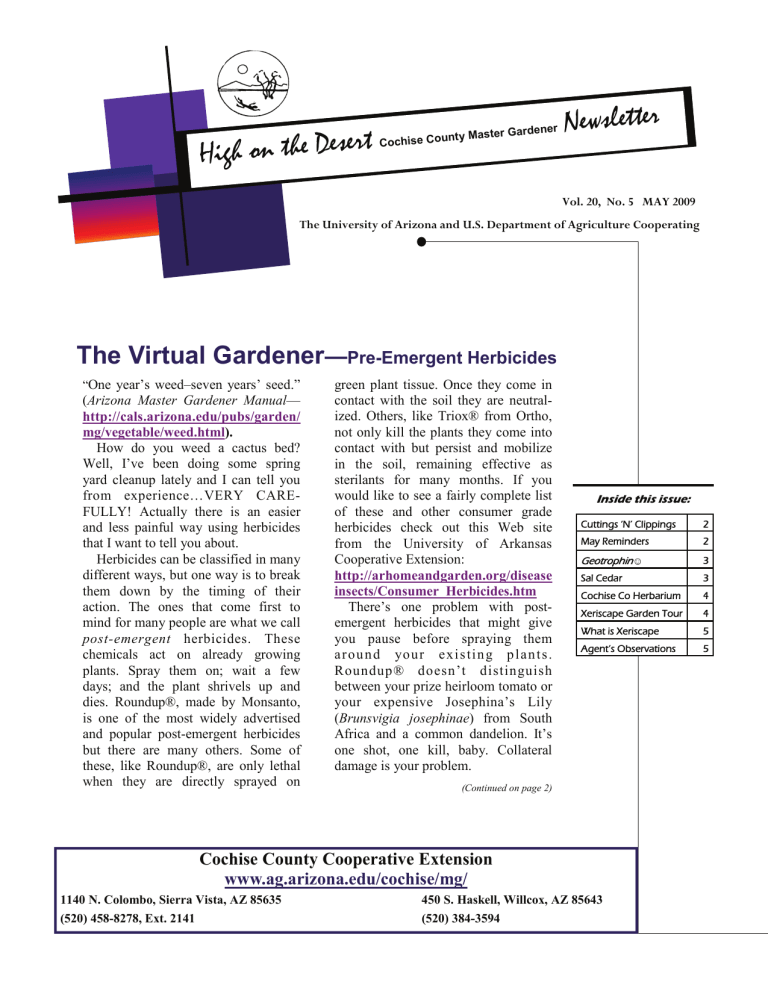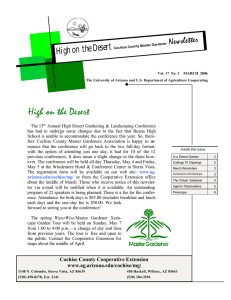Newsletter High on the Desert The Virtual Gardener
advertisement

High on the Desert ardener nty Master G Cochise Cou Newsletter Vol. 20, No. 5 MAY 2009 The University of Arizona and U.S. Department of Agriculture Cooperating The Virtual Gardener—Pre-Emergent Herbicides “One year’s weed–seven years’ seed.” (Arizona Master Gardener Manual— http://cals.arizona.edu/pubs/garden/ mg/vegetable/weed.html). How do you weed a cactus bed? Well, I’ve been doing some spring yard cleanup lately and I can tell you from experience…VERY CAREFULLY! Actually there is an easier and less painful way using herbicides that I want to tell you about. Herbicides can be classified in many different ways, but one way is to break them down by the timing of their action. The ones that come first to mind for many people are what we call post-emergent herbicides. These chemicals act on already growing plants. Spray them on; wait a few days; and the plant shrivels up and dies. Roundup®, made by Monsanto, is one of the most widely advertised and popular post-emergent herbicides but there are many others. Some of these, like Roundup®, are only lethal when they are directly sprayed on green plant tissue. Once they come in contact with the soil they are neutralized. Others, like Triox® from Ortho, not only kill the plants they come into contact with but persist and mobilize in the soil, remaining effective as sterilants for many months. If you would like to see a fairly complete list of these and other consumer grade herbicides check out this Web site from the University of Arkansas Cooperative Extension: http://arhomeandgarden.org/disease insects/Consumer_Herbicides.htm There’s one problem with postemergent herbicides that might give you pause before spraying them a ro u n d yo u r e x i s ti n g p l a n t s . Roundup® doesn’t distinguish between your prize heirloom tomato or your expensive Josephina’s Lily (Brunsvigia josephinae) from South Africa and a common dandelion. It’s one shot, one kill, baby. Collateral damage is your problem. Inside this issue: Cuttings ‘N’ Clippings 2 May Reminders 2 Geotrophin☺ 3 Sal Cedar 3 Cochise Co Herbarium 4 Xeriscape Garden Tour 4 What is Xeriscape 5 Agent’s Observations 5 (Continued on page 2) Cochise County Cooperative Extension www.ag.arizona.edu/cochise/mg/ 1140 N. Colombo, Sierra Vista, AZ 85635 (520) 458-8278, Ext. 2141 450 S. Haskell, Willcox, AZ 85643 (520) 384-3594 PAGE 2 (Continued from page 1) That’s where the second class of herbicides, called preemergents, come in handy. Pre-emergents do not affect plants that are already growing. They prevent seeds from germinating and producing new plants, so you can safely spray them around your expensive lily and not have to worry about killing it. [Actually if I had paid a couple hundred bucks for an expensive exotic plant, I would probably want to get a written guarantee from the manufacturer backed up with some money in an escrow account before I sprayed it with any kind of herbicide!] Pre-emergent herbicides are particularly effective against grasses and other annuals that invade your garden during the monsoon or winter rainy seasons. They should be applied before the moisture arrives and, depending upon the dosage you use, should last for three months or so—enough time to get you through the rains. If you want to suppress weeds for the monsoon season, I would recommend you apply a pre-emergent herbicide during the hot, dry periods of May and June in the High Desert of Southeast Arizona. Don’t spray it around any flower or vegetable beds that you plan to seed but do remember to spray it around those cactus beds so you won’t have that nasty weeding job later. Pre-emergent herbicides are available in most nurseries and garden shops where herbicides are sold, but you may have to look hard for them. Postemergents usually occupy most of the shelf space. Even salespersons sometimes don’t know what you are talking about when you ask for pre-emergents. Read the labels and look for ingredients like Surflan® (generic name, oryzalin) or Treflan® (generic name, trifluralin), which are two of the more commonly available chemicals found in pre-emergents authorized for home use. Terms to look for on the package include “weed preventer,” “weed impede,” “weed blocker,” “weed stopper,” and so on. Whichever product you choose, read the label to determine what types of plants the product controls and how to apply it. Carefully follow the directions on the package to apply these products. Some are dissolved in water for application and others are sprinkled on in dry form. All of them need to be washed into the soil to form a barrier that will prevent weed seedlings from emerging. Until next time, happy surfing. Gary A. Gruenhagen, Master Gardener virtualgardener@cox.net Cuttings ‘N’ Clippings The next CCMGA meeting is 5:00 p.m. Thursday, May 7 at the University of Arizona South Campus Public Meeting Room. The presentation, Flowers and Sex by Cecile Lumer, Ph.D., Curator of the Cochise County Herbarium, will cover the relationships between plants (flowers) and their pollinators. The diversity of pollinators is incredible from the well known honey bees and hummingbirds to rats and mice. See related article on Page 4 of this newsletter. The Sierra Vista Area Gardeners Club will be holding its annual Spring Plant Sale on Saturday, May 9 from 9:00 a.m. to noon at the Bisbee Farmers Market in Vista Park (located in Warren). The club will have available annual flowers, perennials, herbs, vegetables, houseplants, and cacti. May Reminders Robert E. Call Extension Agent, Horticulture Carolyn Gruenhagen Editor ♦ ♦ ♦ ♦ ♦ Deep water Plant warm season crops Check tree ties Control pests Control weeds (Controlling Weeds—a bulletin available from the Cooperative Extension) PAGE 3 Geotrophin☺ A New Hormone Australian researchers at the University of Woomera have announced the discovery of a previo u s l y u n k n o wn be h a v i o r modifying human hormone called geotrophin☺. The hormone is produced in the hypothalamus in a complex response to changing circadian rhythms, photo periods, and accumulating heat units. Although geotrophin☺ is produced in all adult humans, the quantity appears to be genetically controlled. Only about 20% of the population exhibits a geotrophin☺ deficiency. An increased blood serum level of geotrophin☺ manifests itself in an uncontrollable desire to dig in the ground, rake the soil, scatter plant seeds, and apply water to the soil, especially on late spring weekends. In addition, there may be a strong attraction to plant nurseries and garden shops. Although these behaviors may persist for a few weeks, geotrophin☺ levels usually fall off quickly as the days lengthen and heat units continue to accumulate. Reprinted from May 2003 Cochise County Master Gardener Newsletter Salt Cedar Found to be Friend, Not Foe of Western Waterways Water waster, pest plant, an alien invader, the salt cedar or tamarisk is known as a truly villainous plant, the plant that is drinking the West dry. Recent research, however, finds that the much maligned plant can be a valuable and productive member of a riparian plant community. Scientists are concerned, however, that the message has not reached many natural resource managers. More is at stake here than the reputation of the salt ce- dar. Also at issue is the contribution of science to land and water management. Are resource managers using the latest research when determining water management issues? Are they even aware of such research? What must be done to get word out so that research is widely known and used? This is an issue that concerns Ed Glenn, a researcher in the University of Arizona's Environmental Research Laboratory. Glenn is part of a research network that includes scientists from the UA, Arizona State University, U.S. Geological Survey and other agencies and institutions that have studied the salt cedar for over ten years; they argue that the environmental benefits of salt cedar outweigh arguments to eradicate the plant. Read more from the November-December 2008 issue of Arizona Water Resource at the link: http://cals.arizona.edu/azwat er/awr/13494048-c0a8-01620028-c94a8675a8d3.html PAGE 4 Cochise County Herbarium Have you ever thought about how many plants grow in Cochise County? To get a feel for the number, take a walk along the San Pedro or hike up a Sky Island canyon, or just take a good look in the odd corners of your own property and think about how many plants you see. Now think about how much effort it would take to collect multiple specimens of each of the plants in the county, identify them, press and dry them, enter data about them into a database, and store the dried specimens for posterity. That is the mission of the Cochise County Herbarium. The Cochise County Herbarium, like all herbaria, is essentially a museum of preserved plants. Its collection serves as a reference for botanists involved in identifying and classifying plants, and it also preserves important information about the geographic and temporal distribution of plants in the county, their diversity, their ecology, and their genetic makeup. In addition to serving the needs of researchers, the herbarium also provides a valuable teaching resource. The Cochise County Herbarium, founded by botanist Cecile Lumer, Ph.D. in 2002, is located in a tiny building at the Plant Sciences Center on the campus of the University of Arizona South. From this humble structure herbarium curator Dr. Lumer and her tiny staff of volunteers conduct the effort to catalog and describe all the plants of Cochise County. And now you can see some of the fruits of their labor on their website . . . http:www.cochisecountyherbarium. org The Cochise County Herbarium website, like the herbarium itself, is a work in progress. On the website you will find lists of plants collected in Cochise County organized by their Latin names (family-genus-species). Clicking on a genus and species name will bring up a page with data about the specimen, such as the name of the collector, the location where the specimen was collected, and other information. Many pages also show photographs of the specimens, includ- ing a view of the entire herbarium data sheet, a closer view of the plant, and a close-up of its flowers/ fruit. These thumbnail-sized images can be enlarged to screen size by clicking on them. In addition, the site is linked to other plant databases that provide more information about the selected plant than you can imagine, including detailed technical information about their gene sequences, their pharmacology, descriptions of their native habitats and utility in the landscape, and lots of images of the plant. Another interesting link on the site connects to a comprehensive geographic information system (GIS) for Arizona that shows the distribution of plants, animals, geologic and hydrologic features, and human demographic information keyed to maps of the state. (Note: Reprinted from the April 2006, The Virtual Gardener, Cochise County Master Gardener Newsletter) Xeriscape® Garden Tour May 3, 2009 ` 1:00—4:00 p.m. The next Xeriscape (Low Water Landscape) Self Guided Tour will be held on Sunday, May 3, 1:00—4:00 p.m. The tour is sponsored by Water Wise and Cochise County Master Gardeners. Free, low-water use landscapes, called Xeriscapes (pronounced Zir- ih -scapes - remember, there is no “zero” in Xeriscape!), can be colorful, evergreen, soft, easy care and wildlife friendly. Come see beautiful and creative Xeriscape landscapes. When you visit these yards, you will be astonished at how much choice you have in creating your very own water wise yard. Master Gardener docents will be at each yard to answer questions and plant lists will be available. Bring a camera! Contact Joyce at 458-8278, Ext. 2141 for maps or information. During tour hours on May 3, maps will be available at 1640 Driftwood Ct. PAGE 5 The Agent’s Observations W h a t ’s Xeriscape® and Why Should I H a ve I t ? Xeriscape—sounds like some kind of affliction, doesn’t it? Well, you could be very distressed if you don’t have it. Xeriscape or low water use landscaping is the easiest, most carefree type of landscape you can have anywhere—from Florida to the High Desert. The term was coined in 1986 by a group of Denver water conservation professionals. It was the beginning of an educational movement to change the way landscapes are designed. Here in the Southwest, many of us rely solely on diminishing supplies of groundwater. Landscapes are a main focus for water use reduction as this is where the most water is used and can easily be saved. If we can have beautiful landscapes while being water conserving, why not? By following the Principles of Xeriscape, the homeowner can design, install, and enjoy their environment while feeling proud that they are being good stewards of their natural resources. The seven Principles of Xeriscape are: 1. Plan and Design. In Xeriscaping as with almost every other endeavor, a good plan is the key to success. A Xeriscape design is centered around a concept of grouping plants in zones according to their water I live down on the Babocamari River and we are being over run by “tent worms.” They only showed up a few years ago, but now every spring they get worse and worse. They feed on tree leaves. I believe they have killed at least one of my trees. What can be done to eradicate this pest? Is the State or County controlling them? Q We have a couple of species of tent caterpillars in Southern Arizona. A common species is the southwestern tent caterpillar Malacosoma incurvum (Edwards). Most tent caterpillars have one generation per year. There are several options for tent caterpillar control. You can cut off the branch that is infected and burn it. You can spray a pesticide inside and around the tent. Bacillus A thuringiensis or B.t. works well because they are moth larvae. B.t. is sold under a variety of names like “Worm Getter,” “Dipel,” or “Thuricide” to name a few. This insecticide is considered organic and is “soft” on the environment. The larvae have to eat some of the B.t. because it causes their gut to ulcerate and they stop feeding and die. Another approach is to use a high pressure hose and spray the tent and larva out of the tree. Predators, like birds, then eat the larva because they have lost their protective net or tent. In rare cases will tent caterpillars kill a tree. If the tree is young and there are high populations of the caterpillars then perhaps that might happen but unlikely. No, the State or County do not control for this pest. Tent caterpillars are a normal part of nature and will not be eradicated. Robert E. Call Extension Agent, Horticulture (Continued on last page) Issued in furtherance of Cooperative Extension work, acts of May 8 and June 30, 1914, in cooperation with the United States Department of Agriculture, James A. Christenson, Director, Cooperative Extension, College of Agriculture and Life Sciences, The University of Arizona and Arizona Counties cooperating. The University of Arizona is an equal opportunity, affirmative action institution. The University does not discriminate on the basis of race, color, religion, sex, national origin, age, disability, veteran status, or sexual orientation in its programs and activities. The information given herein is supplied with the understanding that no discrimination is intended and no endorsement by Cooperative Extension is implied. Any products, services, or organizations that are mentioned, shown, or indirectly implied in this publication do not imply endorsement by the University of Arizona. The University of Arizona Cooperative Extension Cochise County 450 S. Haskell Avenue Willcox, AZ 85643-2790 PRSRT STD US POSTAGE PAID WILLCOX, AZ PERMIT NO. 70 (Continued from page 5) requirements. High water users are clustered close around the house in a mini “oasis.” Surrounding the oasis is a zone comprising plants of intermediate water requirements, and at the farthest extremes is a zone containing the plants with the lowest water requirements. 2. Create Practical Turf Areas. Turf is the largest consumer of water in most yards. Turf areas are minimized in Xeriscapes. 3. Use Appropriate Plants and Zone the Landscape. This should be obvious. Xeriscapers like to use native plants in their gardens and yards because they are adapted to the local climate. 4. Soil Improvement. The Xeriscaper improves the water retention properties of the soil by adding lots of organic material. 5. Use Mulches. Organic mulches such as straw, bark or compost, or inorganic rock mulches trap moisture and keep the soil cool to minimize loses to evaporation. 6. Irrigate Efficiently. Use drip irrigation wherever possible to cut down on water usage. 7. Maintain the Landscape Appropriately. Once you have installed your Xeriscape, check it periodically to make sure it is doing what you intended. Be sure to check your irrigation system for leaks. For on-line information on Xeriscaping, search Google for the term “Xeriscape” or go to h tt p : / / w w w . x e r i s c ap e .o r g / whatis.html Cado Daily, WaterWise Educator Gardening isn’t just a hobby, it’s a magnificent journey of discovery! -Joseph F. Williamson, Jr. 1925—2000




